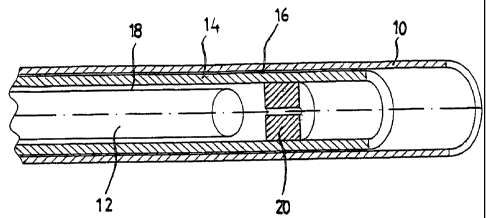Some of the information on this Web page has been provided by external sources. The Government of Canada is not responsible for the accuracy, reliability or currency of the information supplied by external sources. Users wishing to rely upon this information should consult directly with the source of the information. Content provided by external sources is not subject to official languages, privacy and accessibility requirements.
Any discrepancies in the text and image of the Claims and Abstract are due to differing posting times. Text of the Claims and Abstract are posted:
| (12) Patent: | (11) CA 2446446 |
|---|---|
| (54) English Title: | METHOD AND DEVICE FOR GENERATING OZONE |
| (54) French Title: | PROCEDE ET DISPOSITIF POUR LA GENERATION D'OZONE |
| Status: | Deemed expired |
| (51) International Patent Classification (IPC): |
|
|---|---|
| (72) Inventors : |
|
| (73) Owners : |
|
| (71) Applicants : |
|
| (74) Agent: | RIDOUT & MAYBEE LLP |
| (74) Associate agent: | |
| (45) Issued: | 2008-12-09 |
| (86) PCT Filing Date: | 2002-05-24 |
| (87) Open to Public Inspection: | 2002-12-05 |
| Examination requested: | 2004-04-07 |
| Availability of licence: | N/A |
| (25) Language of filing: | English |
| Patent Cooperation Treaty (PCT): | Yes |
|---|---|
| (86) PCT Filing Number: | PCT/DE2002/001890 |
| (87) International Publication Number: | WO2002/096798 |
| (85) National Entry: | 2003-11-05 |
| (30) Application Priority Data: | ||||||
|---|---|---|---|---|---|---|
|
The invention relates to a method for generating ozone from gases containing
oxygen. The ozone is generated by
silent electric discharge in an installation comprising at least two gaps,
which are traversed by the gas, each of said gaps being formed
between an electrode and a dielectric that separates each gap from an
additional electrode. According to the invention, the restriction
of the volumetric flow of the gas of at least one gap is controlled.
L'invention concerne un procédé pour la génération d'ozone à partir de gaz contenant de l'oxygène. L'ozone est généré par décharge électrique silencieuse dans un ensemble comprenant au moins deux entrefers traversés par le gaz et formés chacun entre une électrode et un diélectrique qui sépare l'entrefer correspondant d'une autre électrode. Selon l'invention, un étranglement du débit volumétrique du gaz d'au moins un entrefer est commandé.
Note: Claims are shown in the official language in which they were submitted.
Note: Descriptions are shown in the official language in which they were submitted.

For a clearer understanding of the status of the application/patent presented on this page, the site Disclaimer , as well as the definitions for Patent , Administrative Status , Maintenance Fee and Payment History should be consulted.
| Title | Date |
|---|---|
| Forecasted Issue Date | 2008-12-09 |
| (86) PCT Filing Date | 2002-05-24 |
| (87) PCT Publication Date | 2002-12-05 |
| (85) National Entry | 2003-11-05 |
| Examination Requested | 2004-04-07 |
| (45) Issued | 2008-12-09 |
| Deemed Expired | 2016-05-24 |
There is no abandonment history.
| Fee Type | Anniversary Year | Due Date | Amount Paid | Paid Date |
|---|---|---|---|---|
| Application Fee | $300.00 | 2003-11-05 | ||
| Request for Examination | $800.00 | 2004-04-07 | ||
| Maintenance Fee - Application - New Act | 2 | 2004-05-25 | $100.00 | 2004-04-08 |
| Registration of a document - section 124 | $100.00 | 2004-05-21 | ||
| Maintenance Fee - Application - New Act | 3 | 2005-05-24 | $100.00 | 2005-05-03 |
| Maintenance Fee - Application - New Act | 4 | 2006-05-24 | $100.00 | 2006-05-03 |
| Maintenance Fee - Application - New Act | 5 | 2007-05-24 | $200.00 | 2007-05-01 |
| Maintenance Fee - Application - New Act | 6 | 2008-05-26 | $200.00 | 2008-05-01 |
| Final Fee | $300.00 | 2008-09-24 | ||
| Maintenance Fee - Patent - New Act | 7 | 2009-05-25 | $200.00 | 2009-04-30 |
| Maintenance Fee - Patent - New Act | 8 | 2010-05-24 | $200.00 | 2010-04-30 |
| Maintenance Fee - Patent - New Act | 9 | 2011-05-24 | $200.00 | 2011-05-02 |
| Maintenance Fee - Patent - New Act | 10 | 2012-05-24 | $250.00 | 2012-04-30 |
| Maintenance Fee - Patent - New Act | 11 | 2013-05-24 | $250.00 | 2013-04-30 |
| Maintenance Fee - Patent - New Act | 12 | 2014-05-26 | $250.00 | 2014-05-19 |
Note: Records showing the ownership history in alphabetical order.
| Current Owners on Record |
|---|
| WEDECO GESELLSCHAFT FUR UMWELTTECHNOLOGIE MBH |
| Past Owners on Record |
|---|
| BILLING, ERNST MARTIN |
| FIEKENS, RALF |
| HOFER, UWE |